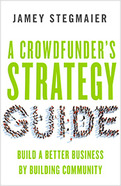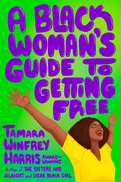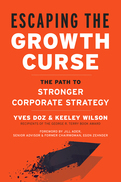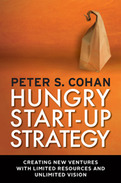Jamey Stegmaier knows crowdfunding. He's a veteran of seven successful Kickstarter campaigns (and counting) that have raised over $3.2 million, and he's the proprietor of the widely read Kickstarter Lessons blog. In this book he offers a comprehensive guide to crowdfunding, demonstrating that it can be a powerful way for entrepreneurs to grow their businesses by building community and putting their customers first.
This book includes over forty stories of inspiring successes and sobering disasters. Stegmaier uses these examples to demonstrate how to (and how not to) prepare for a campaign, grow a fan base, structure a pitch, find new backers, and execute many other crucially important “nuts and bolts” elements of a successful crowdfunding project.
But Stegmaier emphasizes that the benefits of crowdfunding are much more about the “crowd” than the “funding.” He shows that if you treat your backers as people, not pocketbooks—communicate regularly and transparently with them, ask their opinions, attend to their needs—they'll become advocates as well as funders, exponentially increasing your project's chances of succeeding.
In today's fast-moving and combative culture, language can feel like a minefield. Terms around gender, disability, race, sexuality and more are constantly evolving. Words that used to be acceptable can now get you cancelled. People are afraid of making embarrassing mistakes. Or sounding outdated or out of touch. Or not being as respectful as they intended.
But it's not as complicated as it might seem. Linguistic anthropologist Suzanne Wertheim offers six easy-to-understand principles to guide any communication-written or spoken-with anyone:
Reflect reality
Show respect
Draw people in
Incorporate other perspectives
Prevent erasure
Recognize pain points
This guide clarifies the challenges-and the solutions-to using "they/them," and demonstrates why "you guys" isn't as inclusive as many people think. If you follow the principles, you'll know not to ask a female coworker with a wedding ring about her husband-because she might be married to a woman. And you'll avoid writing things like "America was discovered in 1492," because that's just when Europeans found it.
Filled with real-world examples, high-impact word substitutions, and exercises that boost new skills, this book builds a foundational toolkit so people can evaluate what is and isn't inclusive language on their own.
Unshackle your authentic self from the expectations and stereotypes of American culture through the 6 pillars of living free as a Black woman.Empowering, feminist guidance for Black women on living unapologetically and authentically-from the bestselling author of The Sisters Are Alright.
Unshackle your authentic self from the expectations and stereotypes of American culture through the 6 pillars of living free as a Black woman.
Tamara Winfrey Harris harnesses her knowledge as a two-time author and storyteller of the Black femme experience and nationally known expert on the intersections of race and gender to deliver a sharp feminist analysis that is illustrated by real-life stories and examples plucked from popular culture and intimate Black woman-to-Black woman truth-telling.
This book is separated into two parts. First, the meaning of liberation is explored and Black women will be guided in creating sustaining practice to mature their well-being along the freedom journey.
In part two, readers are introduced to the 6 pillars of living free as a Black woman:
- Spot the distortions
- Know your truth
- Celebrate the real you
- Understand the cost of liberation
- Practice freedom
- SEE free Black women everywhere
Public relations is a make-or-break factor for all organizations, especially those that are small or mission driven. While it can be tempting to think that PR is a luxury only larger organizations can afford, PR expert Jennifer R. Farmer shows how her CCRR framework—being credible, creative, responsive, and relentless—is the silver bullet for even cash-strapped organizations.
Farmer emphasizes that effective public relations is in fact an essential component of organizational development—people need to know about you for your organization to have maximum impact. Her CCRR framework leverages tools everyone has access to, from social media to brand transparency, and requires attentiveness more than money. Farmer shows you that, no matter how modest your budget, you can build a cost-effective communications strategy that will help you break through the noise in an information-overloaded world.
As companies mature, their underlying growth naturally slows—this is called the 'growth curse'. It's a pervasive problem that plagues companies, CEOs, and board members alike. In order to safeguard a company's future, a strategic form of governance in which the board plays a more active role on behalf of all stakeholders, must be activated.
This book is comprised of 3 parts. First it shows companies how to identify the traditional traps that hinder growth. The second part provides companies with a blueprint for building their board, defining long-term strategy, and adjustments necessary to serve continued growth. The final part delves into the specific ways that the board and executives must collaborate in relation to strategic renewal.
Reimagining the limits of growth and how companies are run as a consequence provides an escape from the 'growth curse' at last.
Entrepreneurs are hungry. But it's not just because they're living on ramen and adrenaline while they pour their all into their business. Peter Cohan has found it's something deeper: a hunger to create the kind of world they want to work in.
- The first research-based book on business strategy for start-ups
- Based on Cohan's venture investment experience and on his interviews with over 150 start-up CEOs
- Offers specific approaches for six critical start-up decisions
Entrepreneurs are hungry. But it's not just because they're living on ramen and adrenaline while they pour their all into their business. Peter Cohan has found it's something deeper: a hunger to create the kind of world they want to work in. To leave a legacy, they build carefully with limited resources and maintain control of the venture's direction.
For years, students have told Cohan that the seminal business strategy guide, Michael Porter's Competitive Strategy, was too big-company focused. So Cohan -- who once worked with Porter-has written the first business strategy book to address start-ups' very different challenges.
Cohan focuses on six key start-up choices-setting goals, picking markets, raising capital, building teams, gaining market share, and adapting to change-explaining the unique rules start-ups must follow. For example, when setting goals, large corporations try to maximize their long-term return on equity, but resource-poor start-ups have to plan by setting a series of short-term goals-and how they do this will mean the difference between blazing a trail or flaming out. When entering a new market, well-fed companies can invest substantial time and capital before ever launching a product, but hungry start-ups must get an adequate prototype in front of customers fast, get feedback, and quickly develop a viable business model or they'll starve to death.
For each of these six areas, Cohan provides a decision-making approach and lively case studies of what actual entrepreneurs have done. He extracts hard-hitting lessons not only for start-ups but also for investors and even established companies. Hungry Start-up Strategy offers a full menu of vital information for anyone seeking to cook up a thriving business from scratch.
- The first research-based book on business strategy for start-ups
- Based on Cohan's venture investment experience and on his interviews with over 150 start-up CEOs
- Offers specific approaches for six critical start-up decisions
- Click here for the press release
Entrepreneurs are hungry. But it's not just because they're living on ramen and adrenaline while they pour their all into their business. Peter Cohan has found it's something deeper: a hunger to create the kind of world they want to work in. To leave a legacy, they build carefully with limited resources and maintain control of the venture's direction.
For years, students have told Cohan that the seminal business strategy guide, Michael Porter's Competitive Strategy, was too big-company focused. So Cohan -- who once worked with Porterhas written the first business strategy book to address start-ups' very different challenges.
Cohan focuses on six key start-up choicessetting goals, picking markets, raising capital, building teams, gaining market share, and adapting to changeexplaining the unique rules start-ups must follow. For example, when setting goals, large corporations try to maximize their long-term return on equity, but resource-poor start-ups have to plan by setting a series of short-term goalsand how they do this will mean the difference between blazing a trail or flaming out. When entering a new market, well-fed companies can invest substantial time and capital before ever launching a product, but hungry start-ups must get an adequate prototype in front of customers fast, get feedback, and quickly develop a viable business model or they'll starve to death.
For each of these six areas, Cohan provides a decision-making approach and lively case studies of what actual entrepreneurs have done. He extracts hard-hitting lessons not only for start-ups but also for investors and even established companies. Hungry Start-up Strategy offers a full menu of vital information for anyone seeking to cook up a thriving business from scratch.














